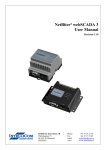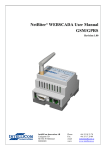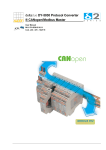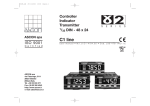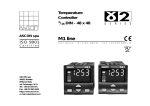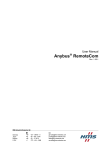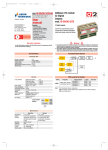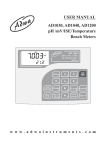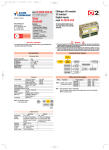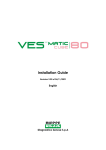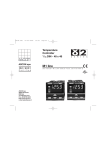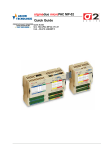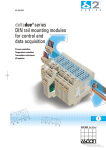Download deltadueDY-5121Protocol Converter ModBUS TCP
Transcript
deltadue DY-5121 Protocol Converter ModBUS TCP/RTU WebSCADA 3 User Manual M.U. DY-5121-3/09.06 Cod. J30 - 478 - 1ADY E Copyright © 2008, 2011 Ascon Tecnologic Srl All rights reserved No part of this document may be stored in a retrieval system, or transmitted in any form, electronic or mechanical, without prior written permission of Ascon Tecnologic Srl. Ascon Tecnologic has used the best care and effort in preparing this manual and believes that the information contained in this publication is accurate. As Ascon Tecnologic continues to improve and develop products, the information contained in this manual may also be subject to change. Ascon Tecnologic reserves the right to change such information without notice. Ascon Tecnologic makes no warranty of any kind, expressed or implied, with regard to the documentation contained in this manual. Ascon Tecnologic shall not be liable in any event - technical and publishing error or omissions - for any incidental and consequential damages, in connection with, or arising out of the use of this manual. sigmadue®, gammadue® and deltadue®, are trademarks of Ascon Tecnologic Srl. All other trade names or product names are trademarks or registered trademarks. Ascon Tecnologic srl Headquarters: via Indipendenza 56, 27029 Vigevano (PV) Milan office: Via Falzarego 9/11, 20021 Baranzate (MI) Phone Fax +39 02 350 4243 +39 02 333 371 www.ascontecnologic.com [email protected] INDEX Prerequisites . . . . . . . . . . . . . . . . . . . . . . . . . . . . . . . . . . . . . . . . . . . . . Updated documentation Using this manual Current Documentation on the Internet Chapter 1 About the Modbus Protocol Converter . . . . . . . . . . . . . . . . . . . 1-1 1-2 1-3 1-4 General . . . . . . . . . . . . . . . . . . . . . . . . . . . . . . . . . . . . . . . . . . . . . . . . Mounting . . . . . . . . . . . . . . . . . . . . . . . . . . . . . . . . . . . . . . . . . . . . . . . Connectors . . . . . . . . . . . . . . . . . . . . . . . . . . . . . . . . . . . . . . . . . . . . . 1-3-1 Bottom Connectors . . . . . . . . . . . . . . . . . . . . . . . . . . . . . . . . 1-3-2 Top Terminal Block . . . . . . . . . . . . . . . . . . . . . . . . . . . . . . . . Indicators . . . . . . . . . . . . . . . . . . . . . . . . . . . . . . . . . . . . . . . . . . . . . . . Chapter 2 Getting Started . . . . . . . . . . . . . . . . . . . . . . . . . . . . . . . . . . . . . . . 2-1 2-2 Configuring the Protocol Converter . . . . . . . . . . . . . . . . . . . . . . . . . . . 2-1-1 The Configuration Utility . . . . . . . . . . . . . . . . . . . . . . . . . . . . 2-1-2 Scanning for connected devices . . . . . . . . . . . . . . . . . . . . . . 2-1-3 Changing IP settings . . . . . . . . . . . . . . . . . . . . . . . . . . . . . . Log In . . . . . . . . . . . . . . . . . . . . . . . . . . . . . . . . . . . . . . . . . . . . . . . . . . Chapter 3 Web-page overview . . . . . . . . . . . . . . . . . . . . . . . . . . . . . . . . . . . 3-1 3-2 3-3 3-4 3-5 3-6 Browser requirements . . . . . . . . . . . . . . . . . . . . . . . . . . . . . . . . . . . . . Menu overview . . . . . . . . . . . . . . . . . . . . . . . . . . . . . . . . . . . . . . . . . . . 3-2-1 Configuration menu . . . . . . . . . . . . . . . . . . . . . . . . . . . . . . . 3-2-2 Setup menu . . . . . . . . . . . . . . . . . . . . . . . . . . . . . . . . . . . . . Status . . . . . . . . . . . . . . . . . . . . . . . . . . . . . . . . . . . . . . . . . . . . . . . . . . 3-3-1 Modem Status . . . . . . . . . . . . . . . . . . . . . . . . . . . . . . . . . . . Devices . . . . . . . . . . . . . . . . . . . . . . . . . . . . . . . . . . . . . . . . . . . . . . . . Alarm . . . . . . . . . . . . . . . . . . . . . . . . . . . . . . . . . . . . . . . . . . . . . . . . . . 3-5-1 Alarm history . . . . . . . . . . . . . . . . . . . . . . . . . . . . . . . . . . . . . Log . . . . . . . . . . . . . . . . . . . . . . . . . . . . . . . . . . . . . . . . . . . . . . . . . . . . v v vi vi 1 1 2 3 3 4 6 7 7 7 7 8 10 11 11 11 12 12 13 13 14 14 15 15 iii Index (continued) Chapter 4 Module Configuration . . . . . . . . . . . . . . . . . . . . . . . . . . . . . . . . . 4-1 4-2 4-3 4-4 17 Workflow . . . . . . . . . . . . . . . . . . . . . . . . . . . . . . . . . . . . . . . . . . . . . . . Create a template . . . . . . . . . . . . . . . . . . . . . . . . . . . . . . . . . . . . . . . . Device configuration . . . . . . . . . . . . . . . . . . . . . . . . . . . . . . . . . . . . . . Pages . . . . . . . . . . . . . . . . . . . . . . . . . . . . . . . . . . . . . . . . . . . . . . . . . . 4-4-1 Adding parameters to web-page . . . . . . . . . . . . . . . . . . . . . . 4-4-2 Picture . . . . . . . . . . . . . . . . . . . . . . . . . . . . . . . . . . . . . . . . . . 4-4-3 Page name . . . . . . . . . . . . . . . . . . . . . . . . . . . . . . . . . . . . . . Alarm configuration . . . . . . . . . . . . . . . . . . . . . . . . . . . . . . . . . . . . . . . 4-5-1 Defining alarms . . . . . . . . . . . . . . . . . . . . . . . . . . . . . . . . . . . Log configuration . . . . . . . . . . . . . . . . . . . . . . . . . . . . . . . . . . . . . . . . . Bindings . . . . . . . . . . . . . . . . . . . . . . . . . . . . . . . . . . . . . . . . . . . . . . . . 17 17 20 21 22 23 23 23 24 25 26 Chapter 5 Module Setup . . . . . . . . . . . . . . . . . . . . . . . . . . . . . . . . . . . . . . . . 27 4-5 4-6 4-7 5-1 5-2 Users . . . . . . . . . . . . . . . . . . . . . . . . . . . . . . . . . . . . . . . . . . . . . . . . . . Modbus settings . . . . . . . . . . . . . . . . . . . . . . . . . . . . . . . . . . . . . . . . . . 5-2-1 Internal Registers . . . . . . . . . . . . . . . . . . . . . . . . . . . . . . . . . Modem settings . . . . . . . . . . . . . . . . . . . . . . . . . . . . . . . . . . . . . . . . . . 5-3-1 Generic modem settings . . . . . . . . . . . . . . . . . . . . . . . . . . . . 5-3-2 Dial-up/GPRS settings . . . . . . . . . . . . . . . . . . . . . . . . . . . . . 5-3-3 Dial-in settings . . . . . . . . . . . . . . . . . . . . . . . . . . . . . . . . . . . Regional . . . . . . . . . . . . . . . . . . . . . . . . . . . . . . . . . . . . . . . . . . . . . . . . 5-4-1 Time and date . . . . . . . . . . . . . . . . . . . . . . . . . . . . . . . . . . . . 5-4-2 Numbers . . . . . . . . . . . . . . . . . . . . . . . . . . . . . . . . . . . . . . . . 5-4-3 Module information . . . . . . . . . . . . . . . . . . . . . . . . . . . . . . . . Email Setup . . . . . . . . . . . . . . . . . . . . . . . . . . . . . . . . . . . . . . . . . . . . . 5-5-1 SMTP Authentication . . . . . . . . . . . . . . . . . . . . . . . . . . . . . . SNMP Setup . . . . . . . . . . . . . . . . . . . . . . . . . . . . . . . . . . . . . . . . . . . . Web-server Setup . . . . . . . . . . . . . . . . . . . . . . . . . . . . . . . . . . . . . . . . Ethernet (TCP/IP) settings . . . . . . . . . . . . . . . . . . . . . . . . . . . . . . . . . . System . . . . . . . . . . . . . . . . . . . . . . . . . . . . . . . . . . . . . . . . . . . . . . . . . 5-9-1 Backup . . . . . . . . . . . . . . . . . . . . . . . . . . . . . . . . . . . . . . . . . 5-9-2 Firmware . . . . . . . . . . . . . . . . . . . . . . . . . . . . . . . . . . . . . . . . 5-9-3 Tools . . . . . . . . . . . . . . . . . . . . . . . . . . . . . . . . . . . . . . . . . . . 27 29 30 31 31 31 32 32 32 32 33 33 33 34 34 35 36 36 36 37 Appendix A Specifications . . . . . . . . . . . . . . . . . . . . . . . . . . . . . . . . . . . . . . . 39 Appendix B Internal registers . . . . . . . . . . . . . . . . . . . . . . . . . . . . . . . . . . . . . 41 Appendix C SNMP . . . . . . . . . . . . . . . . . . . . . . . . . . . . . . . . . . . . . . . . . . . . . . 43 5-3 5-4 5-5 5-6 5-7 5-8 5-9 iv Prerequisites Updated documentation It is advised that you always check our Internet site (www.ascontenologic.com) for the most current updates. Access the English version by clicking on the English flag and choosing English site. Select: Download/Documentation, and fill the table with: - Typology Manual, - Type: User, - Language: EN • English - Code: DY Click “SEARCH” and - Download the file:Ascon_MU_DY-5121_EN_rev3.zip. Revision list Revision Date Author Chapter Description 1.00 4/2006 ASCON All First release 2.00 3/2007 ASCON All Second release 3.00 6/2009 ASCON All Third release v deltadue DY-5121 - User manual Using this manual Specifications within the text of this manual are given in the International System of Units (SI), with non SI equivalents in parentheses. Fully Capitalized words within the text indicate markings found on the equipment. Words in bold style within the text indicate markings found in the Configuration Tools. Warnings, Cautions and Notes are used to emphasize critical instructions: Indicates an imminently hazardous situation which, if not avoided, will result in death or serious injury. Indicates a potentially hazardous situation which, if not avoided, could result in death or serious injury. DANGER! WARNING Caution Indicates a potentially hazardous situation which, if not avoided, may result in minor or moderate injury, or property damage. Note: Highlights important information about an operating procedure or the equipment. Current Documentation on the Internet Make sure you are always working with the latest version of this document. WARNING ASCON spa reserves the right to make changes to its products in the name of technological advancement. ASCON has taken great care for the accuracy of the contained information, but assumes no responsibility for errors. New manual revisions, when published, and can be found online at: http://www.ascon.it vi Chapter 1 About the Modbus Protocol Converter 1-1 General The protocol converter webSCADA device can be used to connect a Modbus/TCP master to one or several Modbus/RTU slaves and also view Modbus registers on a web-page. The module has a simple configuration interface to define which registers will be viewed on the web-pages. It also contains an alarm-handler to send alarms via email or SMS (requires a GSM-modem) and logging capabilities. This application note describes how to create a configuration in the webSCADA module; it acts as a bridge from Modbus TCP to Modbus RTU, making it possible for a Modbus TCP based controller to connect with Modbus RTU based devices. The webSCADA is a device designed that is not only to provide the bridging function, but to also handle alarm management, data-logging as well as providing a web-based user interface for accessing data. The protocol converter Modbus TCP/RTU supports an RS-232 connection through a 9-pole DSUB and RS-232 or RS-485 through the screw terminals. It also supports 10/100Mbps Ethernet through a standard Ethernet connector (RJ-45). It can be configured via a user-friendly web-interface or by using the Config utility. Note: The Physical serial interface enabled can be changed through the Holding register no. 30 (Physical interface). See Appendix B - Internal registers for details. 1 deltadue DY-5121 - User manual 1-2 Mounting A - Sanp ON B - Snap OFF 1. Snap the device on the DIN-rail (as described in picture A above). 2. Connect the Ethernet cable to the RJ45 connector. 3. Connect the ModbusRTU network to the DSUB connector (RS-232) or the 6-pole RJ12 connector (RS-485). 4. Connect the Power Supply and apply power. 5. Now you can start using the Protocol converter. Use the “DY-5xx1 Config Utility” to configure the IP address and other network settings. See 2-1 - Configuring the Protocol Converter for further information. Note: 2 The default IP address of the webSCADA Protocol converter is 10.200.1.1. Please change this IP-address to a valid address in your network. Also, make sure not to power up more than one network attached Protocol converter before IP-address is changed or DHCP enabled. Chapter 1 - About the Modbus Protocol Converter 1-3 Connectors 1-3-1 Bottom Connectors Serial interface (DSUB-9, RS-232) Ethernet interface (RJ-45, 10/100Mbps) Position Description 1 Serial interface 9-pin DSUB RS-232 2 Ethernet interface, RJ-45 10/100 Mbps ModbusRTU interface and RS-232 The 9-pole DSUB, male connector on the device contains an RS-232 interface. This port can be used to connect any equipment with an RS-232 interface. Aspect 1 5 6 9 Male Connector Ethernet interface Pin no. 1 2 3 4 5 6 7 8 9 Signal CD (Carrier Detect) Rx (Receive) Tx (Transmit) DTR (Data Terminal Ready) GND DSR (Data Set Ready) DSR (Data Set Ready) CTS (Clear To Send) RI (Ring Indicator) The Ethernet interface supports 10/100 Mbps, by using a standard RJ-45 connector. 3 deltadue DY-5121 - User manual 1-3-2 Top Terminal Block Power supply Digital I/O terminals Serial communications terminals At the top of the Protocol Converter there is a screw terminal block that is used for power supply and communication interfaces. Power supply terminals The Protocol Converter can be powered by a 9...28Vdc supply (power requirement 2W) and should be connected as shown in the picture. Power supply Protocol converter 24 Vac AC Line voltage AC 24 Vac Vin + Vin - Hearth ground Power supply Line voltage Protocol c converter 24 Vac AC A 24 Va Vac Vin + Vin - Hearth ground The following pins on the top terminal block are used for power supply: Pin no. 23 24 4 Description Vin (Ground connection) Vin + Chapter 1 - About the Modbus Protocol Converter Digital inputs terminals The digital inputs are opto-isolated and are found at the top terminal block with following pin numbers: Pin no. 20 21 22 Description Digital Input Common Digital Input 1 + Digital Input 2 + The voltage levels for the logic states are: Logic state Description High 10...24 V Low 0...2 V The status of the inputs can be read as Internal Registers. The internal registers can be read from an external device if the gateway functionality is enabled. See paragraph - Ethernet Settings (Modbus TCP) at page 30 for more information. RS-485 interface terminals The following pins on the top terminal block are used for the RS-485 interface: PIN no. 13 14 15 Description RS-485 Line B RS-485 Line A Common A A B B Protocol converter Modbus device Normal wiring diagram Modbus terminal A and B. Note: RS232 iterface terminals Note: The RS-485 interface can not be used at the same time as the terminal block interfaced RS-232. The following pins on the top terminal block are used for the RS-232 interface: PIN no. 15 16 17 Description Common RS-232 Transmit (Ouput) RS-232 Receive (Input) The RS-232 interface can not be used at the same time as the RS-485 interface. 5 deltadue DY-5121 - User manual 1-4 Indicators The LED indicators on the front panel of the Protocol Converter have the following meanings: Name Module status Serial Link Status Activity/Collisions Link 6 Colour ● OFF ● Green ● Orange ● Flashing orange ● Flashing green ● Flashing red ● Orange ● Flashing green ● Flashing red ● OFF ● Green ● Orange Meaning No power Module is running in normal mode During boot-up Error during initialization Serial Packet, receiving Serial Packet, transmitting During boot-up Ethernet Packet, receiving Ethernet Collision detected No Ethernet Link detected Ethernet network detected, 10 Mbps Ethernet network detected, 100 Mbps Chapter 2 Getting Started 2-1 Configuring the Protocol Converter 2-1-1 The Configuration Utility The Config utility is a PC-based configuration utility to set TCP/IP network settings in the device. This utility has the ability to scan the Ethernet network to find the connected devices and let the user set IP-address, net mask, protocol converter, DNS and hostname for each unit. Installation System Requirements • Pentium 133 MHz or higher; • 5 Mbytes of free space on the hard drive; • Win 95/98/ME/NT/2000/XP; • Network Interface Card (Ethernet). Installation Procedure Download the program: Ascon_SW_DY-5xx1_Config.zip from the site www.ascon.it (section download/software). Install and run it. Note: The first time you enter the Software Download area, you need to register yourself, by clicking on the register button. 2-1-2 Scanning for connected devices First ensure that you have connected the devices you want to install on the same Ethernet network as the PC is connected to. Use standard Ethernet cables, straight-through or crossover cable depending on how you connect to the device. See pictures below for details. Connecting the device to a hub or Switch 7 deltadue DY-5121 - User manual Connecting the device directly to a PC When the Config utility is started, it will scan the Ethernet network to find the connected devices. All detected devices will be presented in a list in the main window. If you want to force a new scan for devices, you can press the “Scan” button. IP: The IP address of the device; SN: The subnet mask; GW: The default protocol converter; DHCP: Dynamically assigned IP address ON/OFF; Version:Firmware version; Type: Product type (DY WebServer); MAC: The Ethernet MAC address. Note: Use the “Advanced Options” button to enable the Config DHCP Server. This is useful when you have set DHCP to “On” in the device, but do not have a DHCP-server available on the network. 2-1-3 Changing IP settings To change the IP settings on a detected device, double-click on the device you want to configure in the list of devices. This will open up a dialog where you can enter the desired IP configuration. To obtain the necessary information about IP address, subnet mask etc. please contact your network administrator. 8 Chapter 2 - Getting Started WARNING Do not set DHCP to “ON” if you do not have a DHCP-Server available on the network. Host Name: Here you can enter a hostname of your device (optional). IP Address: The IP address of the device. Netmask: The subnet mask Protocol converter:The default protocol converter Primary DNS: The primary Domain Name Server (optional) Secondary DNS: The secondary Domain Name Server (optional) The default password for authentication of the new settings is “admin”. Pressing “Set“ will cause the device to reboot and after that the new settings will be enabled. Note: You can test the new settings by opening a web-browser and enter the IP assigned to the device. If you selected DHCP and want to know what IP your device have been assigned, you can do a new scan with the Config utility to view the new network configuration information. 9 deltadue DY-5121 - User manual 2-2 Log In Open a web browser (Internet Explorer for example) and enter the IP address you have set on the unit with the Config utility. For example, if you entered the address 10.200.1.1 then you should enter the text below in the address field of the browser and press enter. http://10.200.1.1 Now you should see the login screen: To be able to configure the Protocol converter you should enter “admin” in the user-name box. The default password is “admin”. You can later change the default password to something else (recommended). This will be described in the section “Users”. Note: 10 If you have problems to log in and you are sure that your password is correct, make sure that Caps Lock is not enabled on your keyboard. Chapter 3 Web-page overview 3-1 Browser requirements The web-pages are optimized for Internet Explorer 6.0 and Mozilla Firefox. Other browsers can work as well, but the web-pages might appear differently. The browser must be JAVA enabled to use pages with JAVA content (like the graph page). If it iss not, please visit www.java.com to download a JAVA-plugin for your browser. The picture below shows the welcome screen which is shown when you first log into the module. 3-2 Menu overview To navigate on the web-pages, use the menu items available: Select Page, Status, Devices, Alarm, Log, Configuration and Setup. Menu items Log out button 11 deltadue DY-5121 - User manual 3-2-1 Configuration menu When you choose the Configuration menu, a sub menu will appear. • The “Templates” configuration sub-menu will be used to create, edit and backup templates for your devices. • On the “Devices” screen you define the devices which you connect to the webSCADA. • The “Pages” screen you create and edit the structure of the presentation web-pages and also select parameters to be presented. • On the “Alarm” screen can be used to enable/disable SMS/Email/SNMP alarms, and also to create and modify alarm parameters. • On the “Log” configuration screen it's possible to configure the behaviour of the log-file, and also create/modify log-parameters. • The “Bindings” configuration screen makes it possible to enable automatic parameter “copying” from one Modbus slave to another at a configurable interval. 3-2-2 Setup menu When you choose the Setup menu, a sub menu will appear: • The “Users” screen is where all things related to user management are handled. • The “Modbus” screen handles all ModbusRTU and ModbusTCP configuration. • The “Modem” screen handles all modem configurations (Analogue, GSM, GPRS, dial-up, dial-in). • The “Regional” settings screen configures things like date/time and generic module information. • The “E-mail” screen configures all that is needed to send emails from the webSCADA. • The “SNMP” screen makes it possible to configure SNMP trap properties. • The “Webserver” screen can be used to define which port the webSCADA web-server should use. • The “Ethernet” screen handles all TCP/IP configurations, like IPaddress, DHCP, DNS etc. • The “System” entry recalls the System menu in which Backup, Firmware, Tools and Remote managment can be set. 12 Chapter 3 - Web-page overview 3-3 Status This page shows some status information about the Modbus interface. The status is split into two columns, “Transparent queries” and “Internal queries”. The Transparent fields shows information about requests that originate from a ModbusTCP master attached to the protocol converter, and the Internal fields shows information about requests that originate from either Internal applications (Log/Alarm) and WebPages. Number of connections - Indicates the number of open connections to a Modbus TCP master. Internal queries indicate number of pending queries from WebPages + the internal connection from (Alarm/Log) application. Valid Responses - Counts valid responses from the Modbus/RTU slaves. Serial Timeouts - The number of time-outs from attached slaves. CRC Errors - The number of CRC errors on incoming Modbus/RTU responses. Buffer Overruns - If an incoming Modbus/RTU response is larger than 300 bytes, this will cause the input buffer to overflow. Frame Errors - If an incoming Modbus/RTU response has incorrect length or some other fault in the frame, this will cause a Frame Error. Exception Responses - Counts all exception responses from the connected Modbus/RTU slaves. 3-3-1 Modem Status The modem status field gives information about what state an attached modem is in. Connecting to Internet - Calling Internet Service Provider and negotiate for a connection. Waiting for incoming connection - The unit is waiting for an incoming call. Waiting for Event/Alarm - The unit is in standby mode, and when an alarm or event appear it will connect to Internet. Connection established - A connection to Internet is established and data will be sent. Incoming connection is in progress - There is an incoming call and correct baud rate, username and password is being verified. Modem Dial In/Dial Out disabled - Not possible to connect using the modem. 13 deltadue DY-5121 - User manual 3-4 Devices The Devices menu item is a browser that can browse all parameter in a template for a device and show current values. The page shows a list of all available Modbus devices. A tree with all groups will show when expanding the tree. Open a group by clicking on the group name to see values for each parameter. The Internal Registers will also be available to browse. 3-5 Alarm The Alarm page shows all active and unacknowledged alarms. It is also possible to select to view the status of all configured alarms. Use the button in the lower left area of the screen to toggle between the two modes. 14 Chapter 3 - Web-page overview 3-5-1 Alarm history The “Alarm History” screen shows all alarms that have occurred. To clear this list, click the “clear history” button. 3-6 Log From this page it is possible to download the log file from the webSCADA (if logging has been enabled). Simply click the “download” button to download/view the file, or click the “clear” button to remove all data from the log-file. To view the log-file as a graph, make sure that JAVA is installed on your computer. The graph will show all parameters in the log-file, but in the graph it is possible to select which parameters to show (by clicking on the square next to the parameter name). 15 deltadue DY-5121 - User manual 16 Chapter 4 Module Configuration An important concept for the webSCADA is the usage of templates. This allows the user to define templates for different products and configurations, and then easily re-use and distribute them. A template contains properties for available parameters in a device of a certain type. These properties includes: Parameter Names, Modbus register types and addresses, data scaling and presentation. 4-1 Workflow Follow these steps to get your webSCADA operational: 1. Do all generic Setup, like assigning an IP-address (Setup/Ethernet), add/ modify users (Setup/Users), configure the Modbus interface (Setup/Modbus) and set date/time etc (Setup/Regional). 2. Create a template (Configuration/Templates). A Template consists of one or several groups, and each group is a collection of Modbus Parameters. 3. Define your Devices (Configuration/Devices). A Device is simply a Modbus slave, with a unique Modbus address. For each Device, you apply a Template. 4. Create your Application! Now you can define your web-pages, alarms, log entries and bindings. 4-2 Create a template Clicking on the “Configuration/Templates” link will bring up the following screen: To create a template, click the “add template” button. This will create a “New template” in the list, which you now can edit. This will bring up the “Edit Templates” page where it is possible to add new groups (a collection of 17 deltadue DY-5121 - User manual parameters) and new Parameters. From this page it is also possible to backup, restore and delete templates. Using the button “upload template” it is also possible to upload a template. Note: You must always add a Group, before you can add a Parameter. When you have created a Group, and at least one parameter, it is possible to edit the Parameter by clicking the “edit” button. This will bring up the following screen (Edit Parameter): Note: Click on the “?” to view the online help. The “Edit Parameter” screen contains the following fields: Name - Description of the parameter. Type - Modbus type (Holding, Input, Coil, Discrete) Address - Modbus address Datatype - Defines the datatype of the Modbus register. Can be one of the following: Unsigned 16 - 16-bit positive value Signed 16 - 16-bit value, with sign Unsigned 32 - 32-bit positive value. Most significant word (register) on low address. 18 Chapter 4 - Module Configuration Signed 32 - 32-bit value, with sign. Most significant word (register) on low address. Unsigned 32 (swapped) - 32-bit positive value. Most significant word (register) on high address. Signed 32 (swapped) - 32-bit value, with sign. Most significant word (register) on high address. Float - 32-bit floating point. (IEEE-754) Most significant word (register) on low address. Float (swapped) - 32-bit floating point. (IEEE-754) Most significant word (register) on high address. Double - 64-bit floating point. (IEEE-754) Most significant word (register) on low address. Double (swapped) - 64-bit floating point. (IEEE-754) Most significant word (register) on high address. Scaling - The Modbus register value will be divided by the scale value before presented on the web-page, logged or compared with for alarm. It will be multiplied with the scale value before value is written to a slave device. Examples: Modbus register value = 510, Scale value = 10 -> 51.0 will be viewed on web-page. Modbus register value = 5118, Scale value = 100 -> 51.18 will be viewed on web-page. Web-page input = 127.5 Scale value = 10 -> 1275 will be written to Modbus register. Offset - The Modbus register value will be subtracted with the offset value before it is presented on the web-page, logged or compared with for alarm. If scaling is also in use it is done before the offset is subtracted. The Offset value will be added to the value before value is written to a slave device. If scaling is also in use it is done after the offset is added. Mask - Is used to mask out specific bits from the Modbus register, on the webpage the value is presented in binary. The Modbus register will be masked (logic and) and shifted to the right before the value is presented on the web-page, logged or compared with for alarm. 19 deltadue DY-5121 - User manual Examples: Modbus register value = 214 (D6 hex), Mask = 240 (F0 hex) -> 1101 (13) will be viewed on web-page. Presentation - Defines how a value will be represented on a page. Available options are: Show as value This option will read from the address and present the result at the view-page. Writeable value This option reads the value from the address and presents it. There will be a set button next to the value at the view-page which makes it possible to write to the address. Show with enumeration This option will read the value from the address and present it with the corresponding enum string (See Enum below). Writeable value with enumeration This option will read the value from the address and present it with the corresponding enum string. There will be a drop down next to the value at the view-page where available enum strings will be selectable. A selected value will be written to the address. Enum - here the enum variables is defined in following format [number]=[string]. Each enum is separated by a semi colon ';' with no blank spaces. Examples: 0=Off;1=On 0=Sunday;1=Monday;2=Tuesday;3=Wednesday;4=Thursday;5=Friday;6=Saturday Number of decimals - Defines how many decimals to use for this point. Valid range - defines min and max value for a write parameter. If a user tries to enter a value outside the range, a warning message will appear. When you are finished with the Template, continue to the Device Configuration. 4-3 Device configuration On the Device Configuration page, you define which Modbus slaves are attached to the webSCADA. 20 Chapter 4 - Module Configuration To add a device, click the “add device” button. This will bring up the following screen: Name - A description of the device. Template - Defines which template that should be associated with this device. Modbus/TCP server IP address The IP address for the Modbus/TCP server. If it is a Modbus/RTU device It should be left blank. Modbus/TCP server port The port to connect to the Modbus/TCP server. Modbus default is 502. Modbus slave address Defines the Modbus address of this device. The next step is to create your webSCADA application, by defining the look of the web-pages and which alarms and log-parameters that should be available. 4-4 Pages To create a new page, click the “add page” button. This will bring up the General Page Configuration menu: 21 deltadue DY-5121 - User manual On this page all page properties can be configured. A maximum of 20 Modbus points can be on each page. Next step is to define where to display the parameters. Simply click the “edit” button on the position you want to work with. 4-4-1 Adding parameters to web-page Now select the Device, Group and Parameter and enter a description for this parameter, and finish by clicking the “save settings” button. To check that everything is OK, go to the “Select page” menu, select the page you have been working with and hit the “Go” button. You can also define a “presentation format” and “presentation scaling” on this page. Presentation format - You can select a different presentation for a value on the presentation pages. • Default Value is presented as it is configured in the Device template. • Hexadecimal Value is presented in hexadecimal form. • Binary Value is presented in binary form. Presentation scaling - You can add an additional scaling on the value before it is presented on the web-page. The value will be divided by the scale value before presented on the web-page. It will be multiplied with the scale value before value is written to a slave device. Note: 22 It is normally better to use the scaling in the Device template because that will also include logging and alarm. Chapter 4 - Module Configuration 4-4-2 Picture This option lets you choose a picture to be presented on the page. The picture must not be more than 870 pixels wide and must be in gif, jpg or png-format. The picture will be sent to the device when you press the “Upload” button. To remove a picture from the device, press the “Clear” button. Note: There are maximum 800kB available for pictures. On the General Page configuration section you can see how much space remains. 4-4-3 Page name This field can be used to give the page a more descriptive name. Click the “set as start page” button if this page should be the first page to be presented when logging into the module. It is also possible to change name on the Page menu (default “Overview” and “Advanced Overview”). 4-5 Alarm configuration The Protocol converter can send alarm messages with email, SMS or SNMP (traps). (SMS alarms require an external GSM modem). The alarm functionality can be enabled/disabled on the Alarm configuration page. A maximum of 64 alarm parameters can be configured. 23 deltadue DY-5121 - User manual 4-5-1 Defining alarms To add an alarm point, click on the “edit” button in the Alarm Configuration list. This will bring you to the following screen. Here you need to select which parameter to use, and define the trigger operation that will activate the alarm. You also need to define some properties like alarm class (1...10), and what strings should be in the subject and message field of SMS/Email alarms. Trig On This configures the trig condition for the alarm parameter. It is possible to trigger on a Value (Higher than, Lower than, Equal to, Not Equal to, Change of Value) or on a bit-field (Any bit, Neither bit, All bits). Alarm classCan be used to set different priorities on the alarm (class 1...10) Subject Defines the text to be shown as Subject in the email/SMS Message The body of the alarm message SNMP Trap OID the last number in the SNMP OID that will be used when sending a SNMP trap. This can be used to uniquely identify the alarm (Mandatory) (the other part of the OID can be defined on the SNMP setup screen). 24 Chapter 4 - Module Configuration 4-6 Log configuration The DY webSCADA can be used to log Modbus registers. All data is stored in a CSV-file that can be uploaded to a computer for further analysis in e.g. Excel. A maximum of 64 parameters can be configured. To start logging, click the “start” button. Estimated Log Time Gives estimation about the time before the log file is full. This is an estimation, and will depend on the configuration, i.e. number of pages and parameters configured. The number and size of pictures for the pages will also affect the log file size. If the log interval is set to a predefined time, this will show as the estimated log time. Log interval Defines the time interval for between the samples that is saved to the log file. Log type The log could be circular, which will fill the log with data. When full it can be sent. A new file will be created and the old one is deleted. Maximum send log interval This will set the time when a log should be sent. If a time period is selected the log will be sent with this interval, e.g. at the same minute for every hour when At least every hour is chosen. Send log files as E-mail attachment If a Send log interval is specified the log file is sent as an e-mail attachment to user that has configured this option, see paragraph 5-1 - Users at page 27. Note: The log-file that is stored in the Protocol converter will contain historical data for a max. of two periods as defined in the “Send log files as E-mail attachment” property. i.e. if you set this to every day, the log-file in the Protocol converter will keep a maximum of two days historical data. See also Setup/Regional settings to make sure you have the correct settings for list separator and decimal symbol. To add a log-point, click the “add log parameter” button, and then the “edit” button. This will bring you to the “Edit Log Entry” page. 25 deltadue DY-5121 - User manual Now you can select the Device/Group/Parameter you want to log, and also enter a description for this Log Entry. To finish, click the “save settings” button. 4-7 Bindings Bindings are a feature that allows you to copy parameters from one Modbus device to another. To add a binding, click the “add binding” button. On the “Add Data Binding” screen you choose the Source and Destination parameter, and the interval for the copying of data. 26 Chapter 5 Module Setup If you click on the Setup menu option, a sub menu will appear. Here you can do all necessary setup for things like user administration, modem settings and TCP/IP settings. 5-1 Users If you press the “Users” link you will be transferred to the Users administration page. Here you can add, edit and remove users. To add a user, press the “add user” button, and to modify/remove a user click on the user you want to modify/remove. 27 deltadue DY-5121 - User manual Here you can enter the User ID (used on the login screen), name, contact info and a password. If an e-mail address is entered, then alarms will be sent to this address (if user is configured as an alarm recipient and e-mail alarm is enabled). If a mobile number is entered, then SMS-alarms will be sent to this number (if user is configured as an alarm recipient and SMS-alarm is enabled). To configure a user as an alarm-recipient, enable one or more of “Alarm classes” (Class 1-10). The user will only receive alarms that match this selection. The “Receive log files via E-mail” option configures whether this user will receive logs via Email or not. See Configuration/Log (section 4.6) for more details about this function. The language selection defines which language will be used for this user. The user level defines what the user can do on the web-pages: Read View pages but can't do any configuration or modify Modbus Registers Write Can view pages and modify Modbus registers, acknowledge alarms. Admin Read, Write and also configure the module (templates, devices, pages, alarms, log, and bindings) Super Admin Read, Write, Admin and setup module like users, modem and modbus settings. Note: 28 To add/edit users, you must be logged in as a user with Super admin access. Chapter 5 - Module Setup 5-2 Modbus settings If you press the Configuration/Modbus menu you will be presented with the following view: Serial Settings (Modbus RTU/ASCII) Transmission mode Selects Modbus RTU or Modbus ASCII Slave Response Timeout The time that the module will wait for a response from a slave, before a Serial timeout will occur. (Default 1000 ms) Physical Interface EIA-485 or EIA-232 Baudrate 300, 600, 1200, 2400, 4800, 9600, 19200, 38400, 57600 or 115200 bps. Character Format Select number of stop bits and if parity should be enabled (Odd, Even). Delay between polls Time to delay between Modbus messages. Character delimiter Number of milliseconds between characters in the Modbus frame. Set to zero to use standard Modbus (3.5 characters) Force function code 15 when writing single coil If this option is Enabled, all writes to coils will be done with function code 15. (Useful if slaves don't support function code 05). Force function code 16 when writing single register If this option is Enabled, all writes to registers will be done with function code 16 (useful if slaves do not support function code 06). 29 deltadue DY-5121 - User manual Ethernet Settings (Modbus TCP) Port number Which port to use for Modbus TCP communication (502 default). Gateway Registers The address to the gateway internal registers (if enabled). See section 5.2.1 for details about the internal registers. Server Idle Timeout This parameter gives the idle timeout in seconds for the Modbus/TCP connection. If the protocol converter does not receive any Modbus/ TCP query within this time the connection will be closed. (Default value is 60 seconds). IP Authentication This can be used to configure the IP-number that is allowed to connect to the Gateway. Note: It is of great importance to ensure at the time of the procedure of assigning Modbus device addresses, that there are not two devices with the same address. In such a case, an abnormal behavior of the whole serial bus can occur, the Master being then in the impossibility to communicate with all present slaves on the bus. 5-2-1 Internal Registers If Gateway registers are enabled, queries sent to that address will not be forwarded to the Serial Modbus/RTU network; the protocol converter will respond to these queries by it self. See Appendix B for a list of the internal registers. Valid Modbus commands for internal registers: Command Name 3 Read Holding Registers 6 Preset Single Register 16 Preset Multiple Registers Note: 30 The internal registers are also available as an “internal template”, i.e. the registers can be used on presentation pages and as alarms/log entries. Chapter 5 - Module Setup 5-3 Modem settings On this page you setup an external modem (optional) that can be either a GSM/ GPRS modem or an analogue modem (PSTN). 5-3-1 Generic modem settings Start with selecting the correct type of modem attached (GSM, Analogue, GPRS). Also set the desired baudrate that the webSCADA should connect to the modem with. In this section you can also enter a PIN-code for the GSM-modem. Clicking on the “modem info” button will bring up a screen with some details about the modem (Signal strength etc). 5-3-2 Dial-up/GPRS settings In this section you find configuration to allow the webSCADA to connect to Internet using a modem. Connection trigger - Specifies whether the webSCADA should always be connected to Internet using the modem, or only connect when there is an alarm or event. Host to ping - address to the Host that the webSCADA will ping when sending keep-alive messages for the GPRS connection. Ping timer - Specifies the interval for the keep-alive messages. (Set value as high as possible to avoid unnecessary GPRS traffic). Access Point Name (APN) - This is the gateway for all GPRS traffic. Contact your GSM/GPRS operator for information about this. Phone number - Phone number to dial (e.g. to an Internet Service Provider, ISP). User name - This is the username your ISP have assigned to you. Password - Password to log into the ISP network. 31 deltadue DY-5121 - User manual 5-3-3 Dial-in settings The dial-in functionality can be used when someone wants to view the web-pages in the webSCADA over a modem-link. Local IP-number - This is the IP-number of the webSCADA, which the remote client will see when creating the PPP-connection. Remote IP-number - This is the IP-number that will be assigned to the remote client, when creating the PPP-connection. Username - This is the login that the remote client will use when creating the PPP-connection. Password - This is the password that the remote client will use when creating the PPP-connection. Note: 5-4 If you want to view the web-pages on a slow link (like GSM/GPRS), there is a special low-bandwidth version of the pages available. Enable this functionality on the Setup/Webserver page. Regional The Regional page contains configuration for time and date, generic module information and also configuration for how the log file list separator and decimal symbol should be represented. 5-4-1 Time and date Configures the real-time clock on the module. The clock will continue to work during power-loss (max. 1 week). To use NTP (Network Time Protocol), enable it and enter an NTP-server (or use the default configuration). Also set the update interval (how often NTP will synchronise the time). 5-4-2 Numbers The list separator and decimal symbol should be selected so it matches the configuration on the computer where the file will be analysed. 32 Chapter 5 - Module Setup 5-4-3 Module information The “Site Name” string can be used to add information about where the module is located (address, building id etc.). The site name is shown left to the log out button in the user interface header. The “More information” field can be used to do notes about the installation. 5-5 Email Setup The following configuration properties are available: Sender - From field in the alarm mail. Example “DY - WebSCADA” Reply path - The E-mail address to send a mail to when someone reply on an alarm mail. SMTP server - IP-number or domain name to the SMTP server that the module should use when sending E-mails. If domain name is used make sure that you have entered a DNS under the Network configuration. SMTP Authentication - Authentication method: Auto, plain, login or cram-MD5 - Username - Password 5-5-1 SMTP Authentication If the SMTP server require authentication you should enable SMTP Authentication. There are several types of authentication methods supported by the module: auto - The module automatically select the best method supported by the SMTP server. plain - a simple non-encrypted method supported by most SMTP servers. login - a simple non-encrypted method supported by most SMTP servers. cram-md5 - a more secure login method where the username and password is encrypted (this method is not supported by all SMTP servers). 33 deltadue DY-5121 - User manual Note: 5-6 “auto” will not work if only plain and login is supported by the SMTP server, because the module find these methods too insecure, in that case “login” or “plain” must be must be set explicit. To verify the setup, use the Test E-mail functionality. Clicking on the “send” button will generate a test e-mail. SNMP Setup The SNMP Setup page contains configuration to be able to send SNMP traps. Host - The SNMP manager to which SNMP traps should be sent Port - The port number on the SNMP manager to which traps should be sent Community - SNMP community used Enterprise OID - The enterprise OID (Object Identifier) that should be used in the SNMP traps sent. This is the common part of the Enterprise OID that is the same for all traps sent from the webSCADA. Use the OID setting when configuring alarms to set a unique OID for each alarm. 5-7 Web-server Setup The Webserver Setup page contains a configuration to change the port number of the internal web-server in the webSCADA and also enable/disable the low bandwidth pages. Extra webserver port - To connect to the Extra webserver port the URL should have a colon (:=) followed by the new port number, i.e. http://10.10.10.30:8080 where 10.10.10.30 is the IP number or DNS address to the Protocol converter and :8080 the new port. Compression on web pages - This feature is only used for the extra webserver port. When set to enable the Protocol converter check if the browser support compressed pages, and if that is the case will send compressed pages. This feature will increase the workload of the Protocol converter, why it is enabled as default. There is an option to disable compression and the pages will be sent as normal web pages, which always is the case for the standard web server port 80. If it is set to force web pages will always send compressed regardless the support of the web browser. The information that a web-browser supports compressed data could sometimes be removed when passing some firewall or proxy servers. This is true for the default setting port 80 in Microsoft ISA servers. To ensure that compressed web pages are sent anyway the option force should be set. Most web-browsers support compressed data. 34 Chapter 5 - Module Setup Auto update value and status - This feature is only used for the extra webserver port. To limit the amount of data transferred and increase speed when using low bandwith, i.e. modem connection, the data and values could be set to be updated by clicking the refresh button only. This button is shown at the upper right corner of the user interface. Automatic logout time - Defines the time-interval before a user is logged out from the web-server. WARNING If domain name is used make sure that the DNS setting for the Ethernet connection is correct. Notes: 1. The webserver always listen to port 80. When using modem connection, compression on web pages will always be enabled and Auto update will always be disabled to improve response time, and the refresh button has to be clicked to update values and status. 2 Changing the Webserver port will disable Webserver on default port 80. 5-8 Ethernet (TCP/IP) settings If you press the Configuration/Network link you will be presented with the following view: On this page you can view and change the TCP/IP network settings in the module. These settings are the same as the ones set by the NetBiter Config utility. 35 deltadue DY-5121 - User manual Dynamic IP - Select this if you have a DHCP server on your network and you want the IP address be assigned automatically by the server. WARNING Do not select the dynamic IP option if you do not have a DHCP server available on the network. Host Name - Here you can enter a hostname of your device (if E-mail alarms should be used this field must contain something) IP Address - The IP address of the NetBiter. Netmask - The subnet mask Gateway - The default gateway Primary DNS: The primary Domain Name Server (optional) Secondary DNS - The secondary Domain Name Server (optional) 5-9 System 5-9-1 Backup The backup functionality makes it possible to backup and restore configurations. Backup Settings To Local Hard Drive - All configurations except Ethernet settings will be backed up. A file with the extensions nbb, short for NetBiter Backup, will be created that can be saved on the local hard drive. Restore module from backup - A file of nbb, NetBiter Backup file, can be used to restore the setup and configuration for the Protocol converter. To bring a module back to Factory default configuration, click the “reset” button. 36 5-9-2 Firmware Note: The information contained in the firmware session are helpful for support purposes. Chapter 5 - Module Setup Select an update file - This is used to update firmware, files with extension nbu, or install patch, files with extension nbp, for the Protocol coverter. Make sure to make a backup before starting to update the firmware, see section Error! Reference ource not found. on page 21. WARNING Latest firmware can be found at http://support .intellicom.se. When clicking update the NetBiter® WS100 will start updating. Sometimes the web browser will not be able to display web pages. Just wait for some minutes and try to view the page again. The communication configuration for Ethernet, modem and NetBiter.net will not be affected which makes it possible to update firmware remotely. MAC address - MAC address of the Protocol converter Ethernet interface. Kernel version - Kernel version used in the istrument. Application version - Application version of the instrument. Patches - If there are patches installed in the system they will be displayed here with version and inforamtion about the patch. Note: The latest firmware and kernel version can be found at http://support.intellicom.se. There is a link to this page at the bottom of the user interface. 5-9-3 Tools Get all log files - Put all log files and system information in a tar-archive. Restart module - By clicking the reboot button the module will restart. Reset To Factory Default Setting - By clicking this button the Protocol converter will remove all settings and configurations and has to be setup and configured as a brand new system. 37 deltadue DY-5121 - User manual 38 Appendix A Specifications Characteristic Ethernet connection Serial interfaces Power Supply Temperature range Humidity range Cover material Mounting option CE certification Value 10Base-T or 100Base-TX (IEEE 802.3). RJ45 connector EIA-232 with full modem control (RTS, CTS, DCD, DTR, DSR, RI); 300… 115.200bps. 9 pole DSUB connector; EIA-485/232, 300...115.200bps screw terminal connection 9… 28 Vac/dc (2W) Operating:-40… +85°C; Sorage: -40… +85°C 5… 93% RH, non-condensing Grey plastic, LEXAN 940, self-extinguishing according to to UL94-V0 DIN rail (EN 50022) According to EN 50 081-2:1993 and EN 61000-6-2:1999 39 deltadue DY-5220 - User manual 40 Appendix B Internal registers Holding register 1 2 3 4 5 6 7 8 9 10 11 12 13 14 15 16 17 18 19 20 21 22 23 24 Name Values Option Digital input 1 status 0 or 1 Digital input 2 status 0 or 1 Number Active Connections MB/TCP 0...10 Number Active Internal Connections 0...10 Serial Status (Modbus/TCP) Valid responses 0...65535 Serial timeouts 0...65535 CRC errors 0...65535 Input Buffer overruns 0...65535 Frame errors 0...65535 Exception responses 0...65535 Serial Status (Buffered messages) Valid responses 0...65535 Serial timeouts 0...65535 CRC errors 0...65535 Input Buffer overruns 0...65535 Frame errors 0...65535 Exception responses 0...65535 Serial Status (Internal requests and Webpages) Valid responses 0...65535 Serial timeouts 0...65535 CRC errors 0...65535 Input Buffer overruns 0...65535 Frame errors 0...65535 Exception responses 0...65535 Configuration Registers Modbus/TCP Port 1...65535 Gateway Modbus address (-1)...255 -1 Disabled 0...255 Enabled Comment Read only Read only Read only Read only Can be cleared Can be cleared Can be cleared Can be cleared Can be cleared Can be cleared Can be cleared Can be cleared Can be cleared Can be cleared Can be cleared Can be cleared Can be cleared Can be cleared Can be cleared Can be cleared Can be cleared Can be cleared Default port number is 502 Default 41 deltadue DY-5121 - User manual Holding Name register 25 Modbus/TCP idle timeout 26 27 28 29 30 Baudrate Parity Number of Stop bits Slave timeout time Physical interface Values 0...65535 (s) 0 1...65525 2400...115200 2400 4800 9600 19200 38400 57600 115200 0...2 0 1 2 1...2 25...65535 (ms) 0...2 0 1 2 31 32 33 34 35 36 37 38 42 Valid IP address 1 Valid IP address 2 Valid IP address 3 Valid IP address 4 Mask for Valid IP address 1 Mask for Valid IP address 2 Mask for Valid IP address 3 Mask for Valid IP address 4 Authentication 0...255 0 1...255 0...255 0...255 0...255 0...255 0...255 0...255 0...255 Option Comment Default 60 seconds Disabled Enabled 2400 bps 4800 bps 9600 bps 19200 bps 38400 bps 57600 bps 115200 bps No parity Even parity Odd parity Default value Default Default 1 stop bit Default 1000 ms EIA-485 (screw Default terminals) EIA-232 (DSUB) EIA-232 (screw terminals) Disabled Enabled Enabled Enabled Enabled Enabled Enabled Enabled Enabled First byte of IP address IP address auth disabled Second byte of IP address Third byte of IP address Fourth byte of IP address First byte of mask Second byte of mask Third byte of mask Fourth byte of mask Appendix C SNMP If SNMP Alarms is enabled, see section 7.5.1 page 26, all alarms will be sent as SNMP traps to the specified on the SNMP page, see section 6.6 on page 19. The OID is sent in the following format in numbers: .1.3.6.1.4.1.23312.1.1.2 [IP address][event] .1.3.6.1.4.1.23312.1.1.[trap_id][trap_data] where: 23312 is enterprise ID 1.1 is products DY webSCADA and where event: 1 = Alarm set 2 = Alarm cleared A trap id is divided into five messages with following trap data: #1 Alarm ID #2 Alarm descriptions #3 Class ID (1...10) #4 Class description #5 Alarm severity; where: 0 = indeterminate 1 = critical 2 = major 3 = minor 4 = warning 5 = cleared . See the pictures for example of SNMP trap sent an alarm to warning of high temperature from a DY. 43 deltadue DY-5121 - User manual To try out the SNMP functionality the software Trap Receiver could be used. This program can be found at http://www.trapreceiver.com. Please, check the license for the software. It could be used to examine a trap sent to a PC to better understand the SNMP functionality of the Protocol converter DY webSCADA. 44




















































